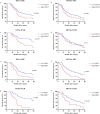Individualized Prognostic Insights: CONUT-GBRS for Survival Prediction in Gallbladder Cancer
- PMID: 40936483
- PMCID: PMC12426482
- DOI: 10.1002/cam4.71203
Individualized Prognostic Insights: CONUT-GBRS for Survival Prediction in Gallbladder Cancer
Abstract
Background: The most suitable prognostic prediction system for gallbladder cancer (GBC) is yet to be determined. This study aims to establish a combined score integrating preoperative patients' nutritional and immune status and pathological parameters to forecast the survival outcomes following curative-intent surgery of GBC.
Methods: This retrospective study included patients diagnosed with GBC based on postoperative pathological examinations. The patients underwent curative surgery at West China Hospital of Sichuan University (China) between January 2014 and December 2022. Using the controlling nutritional status (CONUT) score and gallbladder cancer predictive risk score (GBRS), we generated the CONUT-GBRS for every patient, and the patients were divided into two groups based on the optimal cutoff value. Comparisons were made between the two groups regarding clinicopathologic features and survival.
Results: The optimal cutoff value for the CONUT-GBRS was 1.39. There were 99 and 201 individuals in the high and low CONUT-GBRS groups, respectively. Patients with high CONUT-GBRS experienced poorer overall survival and disease-free survival compared with those with low CONUT-GBRS, even after propensity score matching analysis. Both univariate and multivariate Cox analyses established that CONUT-GBRS stood as an independent prognostic factor for GBC patients. Subgroup analysis indicated that CONUT-GBRS was also an effective predictor of prognosis in patients with incidental GBC.
Conclusion: The CONUT-GBRS serves as an advantageous, straightforward, and cost-effective prognostic tool for GBC, offering valuable prognostic insights and guiding the tailoring of individualized treatment strategies to improve patient outcomes.
Keywords: controlling nutritional status (CONUT) score; gallbladder cancer; gallbladder cancer predictive risk score (GBRS); prognosis.
© 2025 The Author(s). Cancer Medicine published by John Wiley & Sons Ltd.
Conflict of interest statement
The authors declare no conflicts of interest.
Figures



References
-
- Sung H., Ferlay J., Siegel R. L., et al., “Global Cancer Statistics 2020: GLOBOCAN Estimates of Incidence and Mortality Worldwide for 36 Cancers in 185 Countries,” CA: A Cancer Journal for Clinicians 71, no. 3 (2021): 209–249. - PubMed
-
- Sahara K., Tsilimigras D. I., Kikuchi Y., et al., “Defining and Predicting Early Recurrence After Resection for Gallbladder Cancer,” Annals of Surgical Oncology 28, no. 1 (2021): 417–425. - PubMed
-
- Mochizuki T., Abe T., Amano H., et al., “Efficacy of the Gallbladder Cancer Predictive Risk Score Based on Pathological Findings: A Propensity Score‐Matched Analysis,” Annals of Surgical Oncology 25, no. 6 (2018): 1699–1708. - PubMed
MeSH terms
Grants and funding
- ZYJC21046/1.3.5 project for disciplines of excellence, West China Hospital, Sichuan University
- 2021M692277/The fellowship of China Postdoctoral Science Foundation
- 2021HXBH127/Post-Doctor Research Project, West China Hospital, Sichuan University
- 2021CDZG-23/Sichuan University-Zigong School-local Cooperation project
- 2021HXFH001/1.3.5 project for disciplines of excellence-Clinical Research Incubation Project, West China Hospital, Sichuan University
LinkOut - more resources
Full Text Sources
Medical

